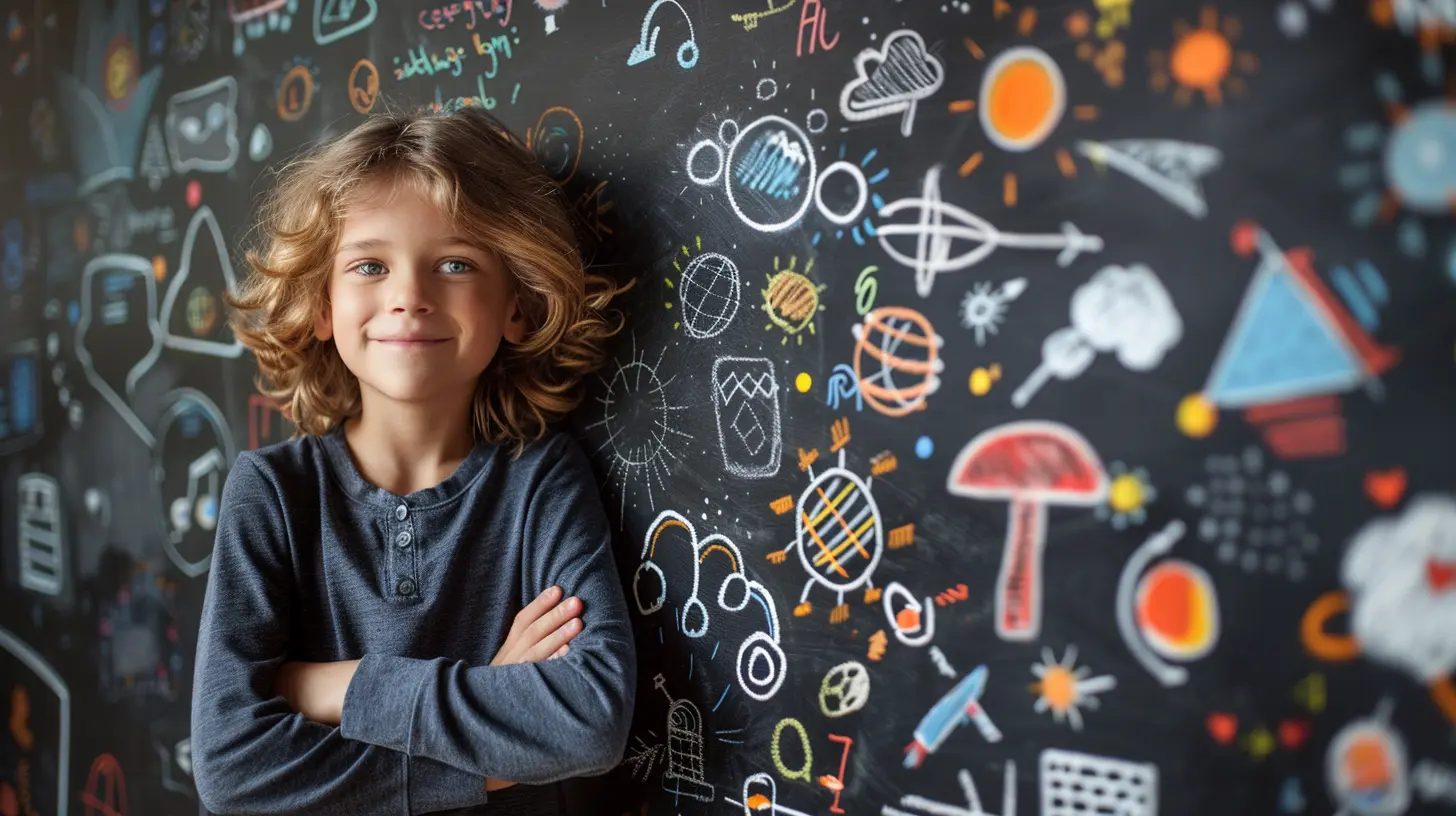Simplifying Complex Concepts with Visual Learning Lesson Plans
28 April 2025
Ever tried explaining quantum physics to a 10-year-old? Yeah, not easy. But what if I told you there's a way to make even the trickiest subjects digestible? That’s where visual learning comes in.
Think about it—our brains are wired for images. Studies show that we process visuals 60,000 times faster than text. So, why not use that to our advantage in education?
Let’s dive into how visual learning lesson plans can simplify complex concepts and make learning fun. 
The Power of Visual Learning
Imagine trying to tie your shoelaces just by reading text instructions. Frustrating, right? Now, picture a step-by-step diagram. Much easier! That’s the beauty of visual learning—it turns abstract ideas into something our brains can grasp effortlessly.Using diagrams, charts, illustrations, and videos can help students connect the dots faster than reading dense paragraphs. And the best part? It works for all subjects—math, science, history, even literature!
Why Visual Learning Works
Visual learning isn’t just a buzzword. It’s backed by science. Here’s why it works:✔ Enhances comprehension – Images break down complex information into digestible chunks.
✔ Boosts memory retention – People remember 80% of what they see versus only 20% of what they read.
✔ Engages multiple learning styles – It appeals to visual learners, kinesthetic learners, and even auditory learners when combined with narration.
✔ Reduces cognitive load – Visuals make learning less overwhelming by organizing information logically.
Want to make your lessons stick? Show it, don’t just say it! 
How to Incorporate Visual Learning into Lesson Plans
Now that we know visual learning is the real deal, let’s talk about how to use it effectively in lesson plans.1. Use Infographics for Data-Heavy Concepts
Numbers and statistics can feel like a foreign language. Instead of overwhelming students with a wall of text, turn data into infographics.For instance:
- In geography, use climate maps to compare weather patterns across regions.
- In history, create a timeline of major events instead of a dry list of dates.
- In science, illustrate the food chain with images rather than just text descriptions.
Infographics make abstract numbers more relatable. Plus, they look way cooler than plain text!
2. Make Abstract Ideas Concrete with Diagrams
Words can only do so much when explaining things like the water cycle, photosynthesis, or electrical circuits. Diagrams paint the picture instantly.Think about it… trying to describe how a heart pumps blood is tricky. But a labeled heart diagram? Crystal clear!
Encourage students to draw their own diagrams too. This reinforces learning and makes lessons interactive.
3. Incorporate Mind Maps to Connect Ideas
Ever feel lost in a maze of information? Mind maps organize thoughts visually, connecting ideas in a logical way.For example:
- In literature, create a character relationship map for novels.
- In biology, use a classification tree to organize animal species.
- In history, map out cause-and-effect relationships of major events.
Mind maps help students see the big picture and understand how different concepts are linked.
4. Bring Learning to Life with Videos and Animations
Let’s be real—students LOVE videos. And for good reason. Moving visuals engage both auditory and visual learners, making lessons twice as effective.Try using:
🎥 YouTube explainer videos—Perfect for simplifying difficult topics.
🎥 Animated tutorials—Great for subjects like physics or chemistry.
🎥 Virtual field trips—Take students to Egypt’s pyramids without leaving the classroom.
When words fail, visuals step up. A well-placed video can turn confusion into clarity in minutes!
5. Gamify Learning with Visual Puzzles and Interactive Tools
Who said learning can’t be fun? Incorporate puzzles, interactive games, or virtual simulations to keep students engaged.Some ideas include:
🎮 Jigsaw puzzles of historical events to teach chronology.
🎮 Drag-and-drop anatomy tools to learn about the human body.
🎮 Math-based puzzle games to reinforce problem-solving skills.
Learning should feel like playing a game, not cracking a code! 
Real-Life Benefits of Visual Learning
Visual learning doesn’t just help students in school—it’s a life skill! From reading maps to understanding graphs, visual literacy is crucial in today’s world.1. Improves Problem-Solving Skills
Visual learners spot patterns and relationships faster, which helps in subjects like math and science.2. Strengthens Creativity
Encouraging students to create their own visuals fuels imagination and innovation.3. Makes Learning Accessible for All
Students with learning disabilities, such as dyslexia, benefit greatly from visual aids. Pictures eliminate decoding difficulties, making lessons more inclusive.4. Prepares Students for the Real World
Infographics, charts, and visual presentations are everywhere—in workplaces, marketing, social media, and more. Mastering visual learning early on gives students a head start.
Tips for Creating Effective Visual Learning Materials
Not all visuals are created equal! Here are some must-follow tips to make your visual lesson plans top-notch:🚀 Keep it simple – Overloading visuals with text defeats the purpose.
🎨 Use color strategically – Colors help differentiate information (but don’t go overboard!).
🔍 Make it relevant – Visuals should directly support the learning objective.
📌 Encourage student participation – Let students create their own visual notes or mind maps.
Remember, the best visuals make complex ideas look simple!
Final Thoughts
Simplifying complex concepts doesn’t have to be a headache. With visual learning lesson plans, students grasp difficult ideas faster, retain information longer, and actually enjoy the learning process.So, the next time you’re tackling a tricky topic, ditch the long-winded explanations. Draw it, map it, animate it, or turn it into a game! Your students (and their attention spans) will thank you.
Would you rather read a textbook page about black holes or watch a jaw-dropping space animation? Thought so.
all images in this post were generated using AI tools
Category:
Lesson PlansAuthor:

Eva Barker
Discussion
rate this article
6 comments
Reese Whitaker
Unlock deeper understanding: Discover how visuals transform chaos into clarity in the classroom's hidden depths.
May 13, 2025 at 7:02 PM

Eva Barker
Thank you! Visuals can indeed simplify complex concepts, making learning more accessible and engaging for students.
Monica Newton
This article offers valuable insights on transforming intricate ideas into engaging visual learning lesson plans. By incorporating visuals, educators can enhance comprehension and retention, catering to diverse learning styles. Practical tips and examples make it an essential read for teachers seeking effective instructional strategies.
May 11, 2025 at 3:32 AM

Eva Barker
Thank you for your thoughtful feedback! I'm glad you found the insights and practical tips helpful for enhancing visual learning in the classroom.
Lara McGeehan
This article effectively highlights the power of visual learning in simplifying complex concepts. However, it is crucial to acknowledge that while visuals enhance understanding, they should not oversimplify nuanced ideas. Striking a balance between clarity and depth is essential to foster critical thinking and comprehensive understanding among students.
May 10, 2025 at 7:24 PM

Eva Barker
Thank you for your insightful comment! I completely agree that while visuals are powerful tools for enhancing understanding, maintaining depth and nuance is vital for promoting critical thinking. Balancing clarity with complexity will ultimately lead to a more comprehensive learning experience.
Kristen McBride
Who knew turning complex concepts into drawings could be my new superpower? Finally, my stick figures can save the day—watch out world, here come the 'artistic educators' armed with colorful markers and big ideas!
May 4, 2025 at 12:37 PM

Eva Barker
Absolutely! Visual learning transforms abstract ideas into accessible knowledge. Your stick figures are a fantastic start—keep drawing and inspiring!
Diana McAdams
This article brilliantly highlights the power of visual learning in simplifying complex concepts. It reminded me of how crucial engaging visuals can be in education, fostering deeper understanding and retention among students. A must-read for educators seeking innovative teaching strategies!
May 2, 2025 at 4:06 AM

Eva Barker
Thank you for your thoughtful comment! I’m glad you found the article valuable for enhancing educational strategies through visual learning.
Quincy McRae
Visual learning transforms complexity into clarity, making challenging concepts more accessible. By incorporating engaging visuals in lesson plans, educators can foster deeper understanding and retention, catering to diverse learning styles effectively.
May 1, 2025 at 4:41 AM

Eva Barker
Thank you for your insightful comment! I completely agree that visual learning enhances understanding and engagement, making complex ideas more approachable for all learners.




